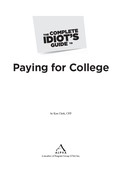When to Use P2P Lending
Like all the tools in your college funding toolbox, there are right and wrong times to use peer-to-peer lending. In general, though, these loans should not be considered as an equal substitute for federal student loans. Likewise, they should not be considered as heinous as many of the private student loans available through corporate loan sharks that don’t participate in the normal public lending channels.
Ultimately, using them comes down to two things: financial cost and borrower flexibility. Typically, both of these are more favorable under government loans—but not always. If any of the following situations exist, you should consider doing some deeper analysis:
• Rates are significantly lower—Although you wouldn’t want to opt for the more restrictive nature of P2P loans over government loans for a savings of just .25 percent, a difference of more than 1 percent begins to beg the discussion. As P2P loan rates drop further from this point, they become a very real consideration that every student or parent should consider. 

CHEAT SHEET
If P2P lending is going to be part of your future, you’ll need to do more research than just reading this chapter. Check out The Complete Idiot’s Guide to Person-to-Person Lending by Curtis E. Arnold and Beverly Blair Harzog (Alpha Books, 2009).
• You’re maxed out—If you cannot get any additional student loans (remember, Stafford and Perkins loans are subject to lifetime limits), these might provide an attractive fallback.
• You’re a parent with bad credit—Because PLUS loans taken out by parents do require a credit check, P2P loans might be a good fallback for those who can’t qualify. However, because Stafford and Perkins loans do not require a credit check on the student borrowing the money, they should not replace these loans unless the rates are substantially better.
• You need a swing loan—If tuition is due now but your next financial aid disbursement is months away, you might want to use a P2P loan to fill the gap and then use your future financial aid disbursement to pay off the P2P loan. Before you do this, though, check to see what your school’s policy is on late payments. If it’ll give you a grace period or charge a rate of interest lower than your potential P2P loan, you should avoid borrowing.
• For surprise expenses—Whether it is replacing a crashed laptop or a crashed car, a P2P loan can cost a lot less over time than charging those amounts to a credit card with an annual interest rate of 29.99 percent.
• Your only other option is raiding your retirement—Because you might lose anywhere from 10 to 50 percent of your retirement account’s value when raiding it for college-related expenses, taking out a P2P loan might give you time to figure out other options without forking over a substantial slice of your retirement to the IRS.
• You’d rather pay interest to family—Although a student or parent should always think of her own finances first and foremost, the idea of paying 8.5 percent annually to Grandma might be a lot more attractive than handing it to some of the financial giants that spent part of the last decade ruining our economy. I talk more about intrafamily borrowing a little later in the chapter.

FLUNK-PROOF FINANCES
One of the biggest borrowing mistakes many college students make is getting short-term cash from one of the countless “payday” lenders out there. P2P lending is a great alternative to the exorbitant interest rates charged by these companies, which can lead to years of struggling to pay off even the smallest of loans.
..................Content has been hidden....................
You can't read the all page of ebook, please click here login for view all page.
